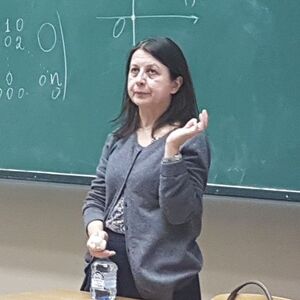Hutton - Fundamentals of Finite Element Analysis (523155), страница 37
Текст из файла (страница 37)
The geometry of the quadrilateral element is described byx =4G i (x , y)x i(6.77)G i (x , y) yi(6.78)i=1y=4i=1where the G i (x , y) can be considered as geometric interpolation functions, andeach such function is associated with a particular node of the quadrilateral4 (⫺1, 1)4 (x4, y4)3 (1, 1)3 (x3, y3)sry1 (⫺1, ⫺1)2 (1, ⫺1)x1 (x1, y1)2 (x2, y2)Figure 6.21 Mapping of a parent element into an isoparametricelement. A rectangle is shown for example.195Hutton: Fundamentals ofFinite Element Analysis1966.
Interpolation Functionsfor General ElementFormulationCHAPTER 6© The McGraw−HillCompanies, 2004TextInterpolation Functions for General Element Formulationelement. Given the geometry and the form of Equations 6.77 and 6.78, eachfunction G i (x , y) must evaluate to unity at its associated node and to zero at eachof the other three nodes.These conditions are exactly the same as those imposed on the interpolationfunctions of the parent element.
Consequently, the interpolation functions for theparent element can be used for the geometric functions, if we map the coordinates so that(r, s) = (−1, −1) ⇒ (x 1 , y1 )(r, s) = (1, −1) ⇒ (x 2 , y2 )(r, s) = (1, 1) ⇒ (x 3 , y3 )(6.79)(r, s) = (−1, 1) ⇒ (x 4 , y4 )where the symbol ⇒ is read as “maps to” or “corresponds to.” Note that the (r, s)coordinates used here are not the same as those defined by Equation 6.54. Instead, these are the actual rectangular coordinates of the 2 unit by 2 unit parentelement.Consequently, the geometric expressions become4x =N i (r, s)x ii=1y=4(6.80)N i (r, s) yii=1Clearly, we can also express the field variable variation in the quadrilateral element as4(x , y) = (r, s) =N i (r, s)i(6.81)i=1if the mapping of Equation 6.79 is used, since all required nodal conditions aresatisfied. Since the same interpolation functions are used for both the field variable and description of element geometry, the procedure is known as isoparametric (constant parameter) mapping.
The element defined by such a procedureis known as an isoparametric element. The mapping of element boundaries isillustrated in the following example.EXAMPLE 6.3Figure 6.22 shows a quadrilateral element in global coordinates. Show that the mappingdescribed by Equation 6.80 correctly describes the line connecting nodes 2 and 3 anddetermine the (x , y) coordinates corresponding to (r, s) = (1, 0.5)■ SolutionFirst, we determine the equation of the line passing through nodes 2 and 3 strictly bygeometry, using the equation of a two-dimensional straight line y = m x + b . Using theHutton: Fundamentals ofFinite Element Analysis6.
Interpolation Functionsfor General ElementFormulation© The McGraw−HillCompanies, 2004Text6.8 Isoparametric Formulation3 (2.5, 2)4 (1.25, 1.75)yx1 (1, 1)2 (3, 1)Figure 6.22 Quadrilateral element forExample 6.3.known coordinates of nodes 2 and 3, we haveNode 2:1 = 3m + bNode 3:2 = 2.5m + bSolving simultaneously, the slope ism = −2and the y intercept isb=7Therefore, element edge 2-3 is described byy = −2x + 7Using the interpolation functions given in Equation 6.56 and substituting nodal x and ycoordinates, the geometric mapping of Equation 6.80 becomesx =111(1 − r )(1 − s)(1) + (1 + r )(1 − s)(3) + (1 + r )(1 + s)(2.5)4441+ (1 − r )(1 + s)(1.25)4y=111(1 − r )(1 − s)(1) + (1 + r )(1 − s)(1) + (1 + r )(1 + s)(2)4441+ (1 − r )(1 + s)(1.75)4Noting that edge 2-3 corresponds to r = 1 , the last two equations become32.55.50.5(1 − s) +(1 + s) =−s2222131y = (1 − s) + (1 + s) = + s222x =Eliminating s gives2x + y =142197Hutton: Fundamentals ofFinite Element Analysis1986.
Interpolation Functionsfor General ElementFormulationCHAPTER 6© The McGraw−HillCompanies, 2004TextInterpolation Functions for General Element Formulationwhich is the same asy = −2x + 7as desired.For (r, s) = (1, 0.5) , we obtain5.50.5−(0.5) = 2.6252231y = + (0.5) = 1.7522x =In formulating element characteristic matrices, various derivatives of the interpolation functions with respect to the global coordinates are required, as previously demonstrated.
In isoparametric elements, both element geometry andvariation of the interpolation functions are expressed in terms of the naturalcoordinates of the parent element, so some additional mathematical complication arises. Specifically, we must compute ∂ N i /∂ x and ∂ N i /∂ y (and, possibly,higher-order derivatives). Since the interpolation functions are expressed in(r, s) coordinates, we can formally write these derivatives as∂ Ni∂ N i ∂r∂ Ni=+∂x∂r ∂ x∂s∂ Ni∂ N i ∂r∂ Ni=+∂y∂r ∂ y∂s∂s∂x∂s∂y(6.82)However, unless we invert the relations in Equation 6.80, the partial derivativesof the natural coordinates with respect to the global coordinates are not known.As it is virtually impossible to invert Equation 6.80 to explicit algebraic expressions, a different approach must be taken.We take an indirect approach, by first examining the partial derivatives of thefield variable with respect to the natural coordinates.
From Equation 6.81, thepartial derivatives of the field variable with respect to the natural coordinates canbe expressed formally as∂∂ ∂ x∂ ∂ y=+∂r∂ x ∂r∂ y ∂r(6.83)∂∂ ∂ x∂ ∂ y=+∂s∂ x ∂s∂ y ∂sIn light of Equation 6.81, computation of the partial derivatives of the field variable requires the partial derivatives of each interpolation function as∂ Ni∂ Ni ∂ x∂ Ni ∂ y=+∂r∂ x ∂r∂ y ∂r∂ Ni∂ Ni ∂ x∂ Ni ∂y=+∂s∂ x ∂s∂ y ∂si = 1, 4(6.84)Hutton: Fundamentals ofFinite Element Analysis6. Interpolation Functionsfor General ElementFormulation© The McGraw−HillCompanies, 2004Text6.8 Isoparametric FormulationWriting Equation 6.84 in matrix form, ∂ Ni ∂x ∂y ∂r∂r ∂r=∂N∂x ∂yi ∂s∂s ∂s∂ Ni ∂x ∂ Ni∂yi = 1, 4(6.85)we observe that the 2 × 1 vector on the left-hand side is known, since the interpolation functions are expressed explicitly in the natural coordinates.
Similarly,the terms in the 2 × 2 coefficient matrix on the right-hand side are known viaEquation 6.80. The latter, known as the Jacobian matrix, denoted [J], is givenby 4 ∂N4 ∂Nii∂x ∂yxiyi ∂r ∂r i=1 ∂r i=1 ∂r[J] = =(6.86)4 ∂N4 ∂N∂x ∂y iixiyi∂s ∂si=1 ∂si=1 ∂sIf the inverse of the Jacobian matrix can be determined, Equation 6.85 can besolved for the partial derivatives of the interpolation functions with respect to theglobal coordinates to obtain∂ Ni ∂ Ni ∂ Ni ∂xI11 I12∂r∂r−1= [J]=i = 1, 4(6.87)∂ Ni I21 I22 ∂ Ni ∂ Ni ∂y∂s∂swith the terms of the inverse of the Jacobian matrix denoted Ii j for convenience.Equation 6.87 can be used to obtain the partial derivatives of the field variablewith respect to the global coordinates, as required in discretizing a governing differential equation by the finite element method.
In addition, the derivatives arerequired in computing the “secondary” variables, including strain (then stress) instructural problems and heat flux in heat transfer. These and other problems areillustrated in subsequent chapters.As we also know, various integrations are required to obtain element stiffness matrices and load vectors.
For example, in computing the terms of the conductance matrix for two-dimensional heat transfer elements, integrals of theform ∂ Ni ∂ N jdA∂x ∂xAare encountered, and the integration is to be performed over the area of theelement in global coordinates. However, for an isoparametric element such asthe quadrilateral being discussed, the interpolation functions are in terms of theparent element coordinates. Hence, it is necessary to transform such integrals to199Hutton: Fundamentals ofFinite Element Analysis2006.
Interpolation Functionsfor General ElementFormulationCHAPTER 6© The McGraw−HillCompanies, 2004TextInterpolation Functions for General Element Formulationthe natural coordinates. From Equation 6.87, we have∂ Nj∂ Nj∂ Ni ∂ N j∂ Ni∂ Ni= I11+ I12I11+ I12∂x ∂x∂r∂s∂r∂s(6.88)so the integrand is transformed using the terms of [J]−1 . As shown in advancedcalculus [9], the differential area relationship isd A = dx dy = |J| dr ds(6.89)so integrals of the form described previously become A1 1 ∂ Ni ∂ N j∂ Ni∂ Ni∂ Nj∂ Nj|J| dr dsI11dA =+ I12+ I12I11∂x ∂x∂r∂s∂r∂s−1 −1(6.90)Such integrals are discussed in greater detail in later chapters in problem-specificcontexts. The intent of this discussion is to emphasize the importance of theJacobian matrix in development of isoparametric elements.Rather than work with individual interpolation functions, it is convenient tocombine Equations 6.84 and 6.85 into matrix form as ∂[N ] ∂x ∂y ∂[N ] ∂r ∂r ∂x ∂r=(6.91)∂[N ] ∂ x ∂ y ∂[N ] ∂y∂s ∂s∂swhere [N] is the 1 × 4 row matrix[N ] = [N 1N2N3(6.92)N4]and Equation 6.91 in matrix notation is the same as∂∂x ∂x ∂ ∂x∂r ∂r ∂s [N ] = ∂ ∂ y ∂ y ∂ ∂y∂s∂r ∂s[N ](6.93)We use this matrix notation to advantage in later chapters, when we examinespecific applications.While the isoparametric formulation just described is mathematicallystraightforward, the algebraic complexity is significant, as illustrated in thefollowing example.EXAMPLE 6.4Determine the Jacobian matrix for a four-node, two-dimensional quadrilateral elementhaving the parent element whose interpolation functions are given by Equation 6.56.Hutton: Fundamentals ofFinite Element Analysis6.
















